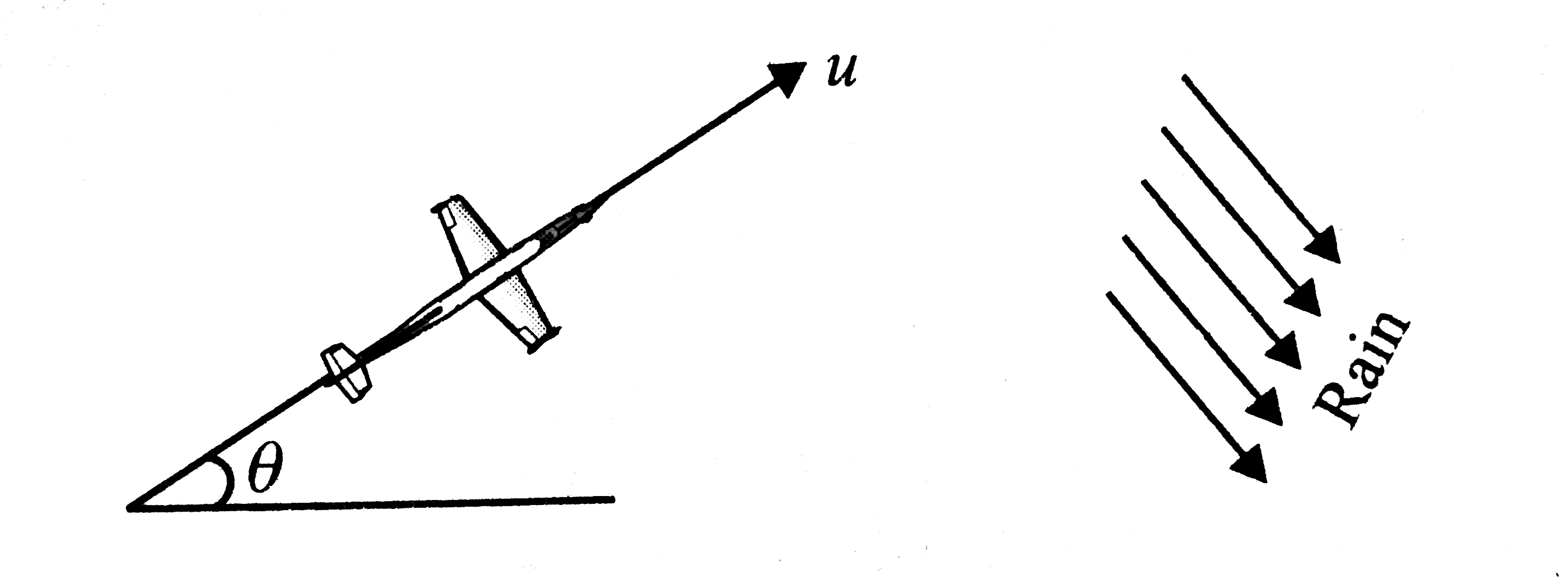A standing man observes rain falling with the velocity of 20ms−1 at an angle of 30∘ with the vertical.
(a) Find the velocity with which the amn should move so that rain appears to fall vertically to him.
Now if he futher increases his speed, rain again appears to fall at 30∘ with the vertical. Find his new velocity.
To solve the problem, we need to analyze the motion of the rain and the man. The rain is falling at an angle of 30∘ with the vertical at a speed of 20m/s.
Step 1: Resolve the rain's velocity into components
The velocity of the rain can be resolved into two components:
- Vertical component (Vry): This is the component acting downward.
- Horizontal component (Vrx): This is the component acting horizontally.
Using trigonometry:
- Vry=Vr⋅cos(θ)
- Vrx=Vr⋅sin(θ)
Where:
- Vr=20m/s (the speed of the rain)
- θ=30∘
Calculating these components:
Vry=20⋅cos(30∘)=20⋅√32=10√3m/s
Vrx=20⋅sin(30∘)=20⋅12=10m/s
Step 2: Determine the velocity of the man
To make the rain appear to fall vertically, the horizontal component of the man's velocity (Vm) must equal the horizontal component of the rain's velocity (Vrx):
Vm=Vrx=10m/s
Step 3: Calculate the new velocity of the man when he increases his speed
If the man increases his speed, the rain again appears to fall at 30∘ with the vertical. This means that the new horizontal component of the rain's velocity must equal the new horizontal velocity of the man.
Let the new velocity of the man be V′m. The new horizontal component of the rain's velocity remains 10m/s, but now the man moves faster, so we can say:
V′m=Vrx+Vrx=10+10=20m/s
Final Answers
(a) The velocity with which the man should move so that the rain appears to fall vertically to him is 10m/s.
(b) If he further increases his speed, the new velocity is 20m/s.
The velocity of the rain can be resolved into two components:
- Vertical component (Vry): This is the component acting downward.
- Horizontal component (Vrx): This is the component acting horizontally.
- Vry=Vr⋅cos(θ)
- Vrx=Vr⋅sin(θ)
- Vr=20m/s (the speed of the rain)
- θ=30∘
Vry=20⋅cos(30∘)=20⋅√32=10√3m/s
Vrx=20⋅sin(30∘)=20⋅12=10m/s
To make the rain appear to fall vertically, the horizontal component of the man's velocity (Vm) must equal the horizontal component of the rain's velocity (Vrx):
Vm=Vrx=10m/s
If the man increases his speed, the rain again appears to fall at 30∘ with the vertical. This means that the new horizontal component of the rain's velocity must equal the new horizontal velocity of the man.
V′m=Vrx+Vrx=10+10=20m/s
(a) The velocity with which the man should move so that the rain appears to fall vertically to him is 10m/s.
Topper's Solved these Questions
- KINEMATICS-2Book:CENGAGE PHYSICSChapter:KINEMATICS-2Exercise:Solved Examples
Explore 7 Videos
- KINEMATICS-2Book:CENGAGE PHYSICSChapter:KINEMATICS-2Exercise:Exercise 5.1
Explore 15 Videos
- KINEMATICS-1Book:CENGAGE PHYSICSChapter:KINEMATICS-1Exercise:Integer
Explore 9 Videos
- KINETIC THEORY OF GASESBook:CENGAGE PHYSICSChapter:KINETIC THEORY OF GASESExercise:Compression
Explore 2 Videos
Similar Questions
To a man going with a speed of 5ms−1, rain appears to be falling vertically. If the actual speed of rain is 10ms−1, then what is the angle made by rain with the vertical ?
View SolutionTo a man walking due east at the rate of 2kmh−1, rain appears to fall vertically. When he increases his speed to 4kmh−1, its appears to meet him at an angle of 45∘. Find the real direction and speed of rain.
View Solution
Knowledge Check
To a man walking at the rate of 3km/h the rain appear to fall vertically downwards. When he increases his speed 6km/h it appears to meet him at an angle of 45∘ with vertical. Find the speed of rain.
A√2km/hB2√2km/hC3√2km/hD5√2km/hWind is blowing in the north direction at speed of 2 m/s which causes the rain to fall at some angle with the vertical. With what velocity should acyclist drive so that the rain appears vertical to him:
A2 m/s southB2 m/s northC4 m/s westD4 m/s southA man moves on a cycle with a velocity of 4 km/hr. The rain appears to fall on him with a velocity of 3 km/hr vertically. The actual velocity of the rain is
A7 km/hrB5 km/hrC4/3 km/hrD3/4 km/hr
A man moving with 5ms−1 observes rain falling vertically at the rate of 10ms−1. Find speed of the rain with respect to ground.
View SolutionA person walking ,on a horizontal road at 2 km/h finds that the rain is falling vertically . Now the person increasses his speed to 4 km/h and find that rain makes an angle 45∘ with the vertical . Find the velocity of rain with respect to the road.
View SolutionRain is falling with a sped of 12√2m/s at an angle 45∘ with the vertical line. A man in a glider going at a speed of u at an angle of 37∘ with respect to the ground. Find the speed of the glider so that rain appears to him falling vertically. Consider the motion of the glider and rain drops in the same vertical plane.

View SolutionTo a stationary man, rain appears to be falling at his back at an angle 30∘ with the vertical. As he starts moving forward with a speed of 0.5ms−1, he finds that the rain is falling vertically.
The speed of rain with respect to the moving man is.
View SolutionTo a stationary man, rain appears to be falling at his back at an angle 30∘ with the vertical. As he starts moving forward with a speed of 0.5ms−1, he finds that the rain is falling vertically.
The speed of rain with respect to the stationary man is.
View Solution